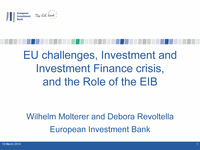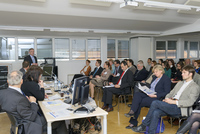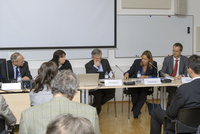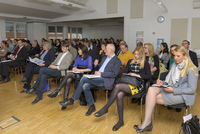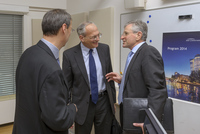The Investment and Investment Finance Crisis: The Role of the EIB
Monday, March 10
Europe faces an ongoing investment crisis. The long-term misallocation of investment across sectors and countries is at the heart of the problem, while the most immediate cause of investment decline during the crisis has been uncertainty. The presentation and discussion focused on:
- What went wrong?
- What needs to be done?
- What support can the EIB give?
Panelists
Wilhelm Molterer, Vice-President EIB and former Minister of Finance, Republic of Austria
Debora Revoltella, Director Economic Department, EIB
Doris Ritzberger-Grünwald, Director Economic Analysis Department, OeNB
Michael Landesmann, Director of Research, The Vienna Institute for International Economic Studies
Press Release
Pressemeldung
Summary
On March 10, 2014, the European Investment Bank (EIB) presented its new report on Investment and Investment Finance in Europe. The report documents a historical decline in investment and concludes that increased crisis-related uncertainty rather than the supply of finance was the main cause. To reverse this trend, the report calls for policy actions aimed at institutional reforms and providing investment finance where financing gaps may exist.
Mr. Wilhelm Molterer, Vice-President of the EIB, started the presentation by highlighting that despite clear signs of recovery, Europe was still experiencing a serious investment crisis, which exerted a considerable drag on potential growth. Reviving investment is therefore a crucial task going forward. The normal investment process is currently complicated as governments follow fiscal austerity measures and banks restructure their portfolios to meet tighter prudential rules. International financial institutions like the EIB could play a more active role in restoring investment and growth, he said.
Ms. Debora Revoltella, Director of the Economic Department at the EIB, emphasized that a future agenda needs to build on answers to two questions. First, what held investment back? And secondly, what policies are necessary to boost investment? While she recognised that long term potential growth is a variable extremely difficult to estimate, she also showed that the decline in potential growth estimated by the EC for the EU between 2013 and 2007 is to a large extent explained by lower capital accumulation. There is, however, a substantial degree of heterogeneity across the Union. For the new member states (NMS), the decrease in employment was another, no less critical, factor.
Although the investment crisis in Europe was rather pronounced, it was unevenly distributed. The correction was deeper in vulnerable countries that had experienced a boom in residential and non-residential construction.
As to the causes of the investment crisis in the EU, Ms. Revoltella pointed out that the return on investment was not a key factor, although it had declined. She identified the level of uncertainty regarding economic policy as the most important force, which until now remains stubbornly high. The availability of finance does not seem to be the major constraint across the board, but it might have been a relevant factor in some countries and for some firms. Intra-EU capital flows collapsed after the crisis and countries had to rely more on domestic sources of funding. This trend was reflected in a stronger link between saving and investment rates.
To address high uncertainty and declining investment, policy efforts should be concentrated on EU institutional reforms, including establishing the Banking Union. Public policy also has to be proactive in covering the existing financing gaps, enhancing bank lending and alternative finance. In a number of countries where the return on investment is low, structural reforms should promote allocating resources to more productive sectors.
Vice-President Molterer continued by pointing out that public policy should include “targeted interventions to ease financing of infrastructure and innovation.” The EIB stands ready for the challenge: it increased its lending from €55bn in 2012 to €75bn in 2013. EIB investment is gradually shifting from the traditional strategic infrastructure investment to innovation, energy efficiency, and financing SMEs.
Ms. Doris Ritzberger-Grünwald, Director of the Economic Analysis and Research Department at the Oesterreichische Nationalbank and a discussant of the EIB report, outlined important differences in the investment and growth dynamics in Austria compared to the rest of the EU. “Austria stands on a brighter side”, she noted, with a relatively low rate of unemployment and a stable investment rate of about 22 percent of GDP (vis-à-vis 17 percent in the EU). Austria was benefiting from a strong competitive position, limited investment in unproductive capacity before the crisis, a well-diversified production structure and strong foreign trade. Austria also enjoyed a relatively balanced structure of investment with a higher share in machinery and equipment and, respectively, a lower share in construction. The private sector played a large and stabilizing role through its traditionally strong investment in R&D with easier access to financing for SMEs also helping to avoid the investment crisis.
The other panelist, Prof. Michael Landesmann, Director of Research at the Vienna Institute for International Economic Studies, pointed to two key factors at the present juncture: a fear of prolonged stagnation and doubts about restarting convergence in Europe. In his view, it is important to investigate the specific causes of the broad economic policy uncertainty which – in his view – the report did not sufficiently specify. At the same time, he said, a number of “certainties” that currently have an adverse effect on investment and long-term growth need revisiting: e.g., the existence of an austerity bias in public finances, and the still relatively limited attention paid to the tradable sector and competitiveness. Prof. Landesmann acknowledged the importance of investment in innovations but at the same time argued that the EU’s R&D policy was focused too much on the “core” EU countries and did not sufficiently take into consideration the specific requirements for an ‘innovation policy’ of low-/medium-income and transition economies in a post-crisis phase where foreign direct investment flows are diminished. Structural policies that go well beyond creating the Banking Union, he noted, may be needed to spur investment, as one of the foremost needs is the strengthening of export capacities in economies which have been undergoing deindustrialization processes over extended periods of time; this lies at the root of longer-term ‘structural balance-of-payments’ problems of a considerable number of Europe’s peripheral economies.
The panelists’ presentations were followed by a general discussion and questions from the audience. Ms. Revoltella concurred with Prof. Landesmann that it would be desirable to pinpoint key factors that drive the uncertainty. She also agreed that innovation is an important issue for all EU members, including the new member states and the “periphery.” Vice-President Molterer stressed that the EIB is an investment bank and as such does not act as a business creator or as a policy-making body. However, the EIB business model allows for mobilizing the expertise of EIB staff and providing funds for sectors that are paramount for future growth and investment in Europe.
For the full report, follow the link: http://www.eib.org/attachments/efs/investment_and_investment_finance_in_europe_en.pdf .
Mikhail Pranovich, Economist, JVI


